Applicability of Precipitation Products in the Endorheic Basin of the Yellow River under Multi-Scale in Time and Modality
Abstract
1. Introduction
2. Materials and Methods
2.1. Study Area
2.2. Data
2.2.1. Precipitation Products
2.2.2. Benchmark Precipitation
2.2.3. Data Processing
2.3. Method
2.3.1. Extreme Precipitation Evaluation Index
2.3.2. Accuracy Evaluation Coefficients
3. Results
3.1. Comparison of Precipitation Product Accuracy across Different Time Scales
3.1.1. Evaluation of Annual Precipitation
3.1.2. Evaluation of Seasonal Precipitation
3.1.3. Evaluation of Monthly Precipitation
3.1.4. Evaluation of Daily Precipitation
3.2. Evaluation of Precipitation Products for Extreme Precipitation
3.2.1. Evaluation of Extreme Precipitation on a Monthly Scale
3.2.2. Evaluation of Extreme Precipitation on a Daily Scale
4. Discussion
4.1. Comparison with Previous Research Findings
4.2. Strategy for Selecting Precipitation Products for Different Application Scenarios
4.3. Errors and Limitations
4.3.1. Limitations of the In-Situ Weather Stations Precipitation Measurements
4.3.2. Selection of Interpolation Methods for Generating Benchmark Precipitation
4.3.3. Comparison and Selection between Different Spatial Resolutions
4.3.4. Exploration of Error
5. Conclusions
- In the average state, the seven precipitation products have similar spatial distribution patterns of annual precipitation, but there are large differences in accuracy on the time series. On the monthly, seasonal, and annual scales, the highest accuracy is GPCC, followed by APHRODITE, JRA55, and PERSIANN-CDR, while ERA5 and MSWEP have the weakest consistency with the benchmark precipitation. Among them, ERA5 and JRA55 generally overestimate precipitation, and MSWEP significantly overestimates individual years or months. On the daily scale, the accuracy of each precipitation product decreases slightly, with the highest accuracy being APHRODITE, followed by MSWEP and GPCC, while the reanalysis and remote sensing precipitation products perform worse.
- In the extreme state, GPCC has the highest overall accuracy, followed by CHIRPS and PERSIANN-CDR. Each precipitation product has different degrees and characteristics of deviation: ERA5 and CHIRPS generally overestimate extreme precipitation, APHRODITE and PERSIANN-CDR generally underestimate, JRA55 is not sensitive enough to the Rx1day index, and the anomaly of MSWEP is reflected in the high degree of deviation of individual monitoring values. In space, each precipitation product can basically show the precipitation distribution pattern from the northwest to the southeast of the study area. Although GPCC has the highest accuracy on the time series, it underestimates the extreme precipitation value in the middle and lower parts of the study area in the spatial distribution of Rx1day.
- Based on the excellent performance of GPCC in average and extreme precipitation, GPCC series products basically meet the application needs of water resource management, water ecological improvement, water environment monitoring, and water disaster prevention and control in the study area, and have the potential to replace ground rainfall observation stations. Remote sensing precipitation products can be used as dynamic input variables in real-time or short-term precipitation scenarios. MSWEP performs excellently in predicting daily average precipitation, while CHIRPS and PERSIANN-CDR stand out in predicting extreme precipitation events. It is recommended to use them in combination with real-time precipitation forecasting or early warning of extreme disaster events.
Author Contributions
Funding
Data Availability Statement
Conflicts of Interest
References
- Nichols, G. Endorheic Basins. In Tectonics of Sedimentary Basins: Recent Advances; John Wiley & Sons: Hoboken, NJ, USA, 2011; pp. 621–632. [Google Scholar]
- Wang, J.; Song, C.; Reager, J.T.; Yao, F.; Famiglietti, J.S.; Sheng, Y.; MacDonald, G.M.; Brun, F.; Schmied, H.M.; Marston, R.A. Recent global decline in endorheic basin water storages. Nat. Geosci. 2018, 11, 926–932. [Google Scholar] [CrossRef]
- Wada, Y.; Van Beek, L.; Viviroli, D.; Dürr, H.H.; Weingartner, R.; Bierkens, M.F. Global monthly water stress: 2. Water demand and severity of water stress. Water Resour. Res. 2011, 47, W07518. [Google Scholar] [CrossRef]
- Wurtsbaugh, W.A.; Miller, C.; Null, S.E.; DeRose, R.J.; Wilcock, P.; Hahnenberger, M.; Howe, F.; Moore, J. Decline of the world’s saline lakes. Nat. Geosci. 2017, 10, 816–821. [Google Scholar] [CrossRef]
- Li, X.; Cheng, G.; Ge, Y.; Li, H.; Han, F.; Hu, X.; Tian, W.; Tian, Y.; Pan, X.; Nian, Y. Hydrological cycle in the Heihe River Basin and its implication for water resource management in endorheic basins. J. Geophys. Res. Atmos. 2018, 123, 890–914. [Google Scholar] [CrossRef]
- AghaKouchak, A.; Behrangi, A.; Sorooshian, S.; Hsu, K.; Amitai, E. Evaluation of satellite-retrieved extreme precipitation rates across the central United States. J. Geophys. Res. Atmos. 2011, 116, D02115. [Google Scholar] [CrossRef]
- Serrat-Capdevila, A.; Valdes, J.B.; Stakhiv, E.Z. Water management applications for satellite precipitation products: Synthesis and recommendations. J. Am. Water Resour. Assoc. 2014, 50, 509–525. [Google Scholar] [CrossRef]
- Xie, P.; Arkin, P.A. Analyses of global monthly precipitation using gauge observations, satellite estimates, and numerical model predictions. J. Clim. 1996, 9, 840–858. [Google Scholar] [CrossRef]
- Li, C.; Tang, G.; Hong, Y. Cross-evaluation of ground-based, multi-satellite and reanalysis precipitation products: Applicability of the Triple Collocation method across Mainland China. J. Hydrol. 2018, 562, 71–83. [Google Scholar] [CrossRef]
- Sun, Q.; Miao, C.; Duan, Q.; Ashouri, H.; Sorooshian, S.; Hsu, K.L. A review of global precipitation data sets: Data sources, estimation, and intercomparisons. Rev. Geophys. 2018, 56, 79–107. [Google Scholar] [CrossRef]
- Ghorbanian, A.; Mohammadzadeh, A.; Jamali, S.; Duan, Z. Performance Evaluation of Six Gridded Precipitation Products throughout Iran Using Ground Observations over the Last Two Decades (2000–2020). Remote Sens. 2022, 14, 3783. [Google Scholar] [CrossRef]
- An, Y.; Zhao, W.; Li, C.; Liu, Y. Evaluation of six satellite and reanalysis precipitation products using gauge observations over the Yellow River Basin, China. Atmosphere 2020, 11, 1223. [Google Scholar] [CrossRef]
- Kobayashi, S.; Ota, Y.; Harada, Y.; Ebita, A.; Moriya, M.; Onoda, H.; Onogi, K.; Kamahori, H.; Kobayashi, C.; Endo, H. The JRA-55 reanalysis: General specifications and basic characteristics. J. Meteorol. Soc. Jpn. Ser. II 2015, 93, 5–48. [Google Scholar] [CrossRef]
- Ma, L.; Zhang, T.; Frauenfeld, O.W.; Ye, B.; Yang, D.; Qin, D. Evaluation of precipitation from the ERA-40, NCEP-1, and NCEP-2 Reanalyses and CMAP-1, CMAP-2, and GPCP-2 with ground-based measurements in China. J. Geophys. Res. Atmos. 2009, 114, D09105. [Google Scholar] [CrossRef]
- Duan, Z.; Liu, J.; Tuo, Y.; Chiogna, G.; Disse, M. Evaluation of eight high spatial resolution gridded precipitation products in Adige Basin (Italy) at multiple temporal and spatial scales. Sci. Total Environ. 2016, 573, 1536–1553. [Google Scholar] [CrossRef]
- Zhou, Z.; Chen, S.; Li, Z.; Luo, Y. An Evaluation of CRA40 and ERA5 Precipitation Products over China. Remote Sens. 2023, 15, 5300. [Google Scholar] [CrossRef]
- Alijanian, M.; Rakhshandehroo, G.R.; Mishra, A.K.; Dehghani, M. Evaluation of satellite rainfall climatology using CMORPH, PERSIANN-CDR, PERSIANN, TRMM, MSWEP over Iran. Int. J. Climatol. 2017, 37, 4896–4914. [Google Scholar] [CrossRef]
- Ehsani, M.R.; Heflin, S.; Risanto, C.B.; Behrangi, A. How well do satellite and reanalysis precipitation products capture North American monsoon season in Arizona and New Mexico? Weather Clim. Extremes 2022, 38, 100521. [Google Scholar] [CrossRef]
- Yuan, S.; Zhu, L.; Quiring, S.M. Comparison of two multisatellite algorithms for estimation of tropical cyclone precipitation in the United States and Mexico: TMPA and IMERG. J. Hydrometeorol. 2021, 22, 923–939. [Google Scholar] [CrossRef]
- Chen, S.; Zhang, L.; Zhang, Y.; Guo, M.; Liu, X. Evaluation of Tropical Rainfall Measuring Mission (TRMM) satellite precipitation products for drought monitoring over the middle and lower reaches of the Yangtze River Basin, China. J. Geogr. Sci. 2020, 30, 53–67. [Google Scholar] [CrossRef]
- Maggioni, V.; Massari, C. On the performance of satellite precipitation products in riverine flood modeling: A review. J. Hydrol. 2018, 558, 214–224. [Google Scholar] [CrossRef]
- Rajulapati, C.R.; Papalexiou, S.M.; Clark, M.P.; Razavi, S.; Tang, G.; Pomeroy, J.W. Assessment of extremes in global precipitation products: How reliable are they? J. Hydrometeorol. 2020, 21, 2855–2873. [Google Scholar] [CrossRef]
- Yong, B.; Ren, L.L.; Hong, Y.; Wang, J.H.; Gourley, J.J.; Jiang, S.H.; Chen, X.; Wang, W. Hydrologic evaluation of Multisatellite Precipitation Analysis standard precipitation products in basins beyond its inclined latitude band: A case study in Laohahe basin, China. Water Resour. Res. 2010, 46, 759–768. [Google Scholar] [CrossRef]
- Yatagai, A.; Kamiguchi, K.; Arakawa, O.; Hamada, A.; Yasutomi, N.; Kitoh, A. APHRODITE: Constructing a long-term daily gridded precipitation dataset for Asia based on a dense network of rain gauges. Bull. Am. Meteorol. Soc. 2012, 93, 1401–1415. [Google Scholar] [CrossRef]
- Schneider, U.; Hänsel, S.; Finger, P.; Rustemeier, E.; Ziese, M. GPCC Full Data Monthly Product Version 2022 at 0.25: Monthly Land-Surface Precipitation from Rain-Gauges Built on GTS-Based and Historical Data; Global Precipitation Climatology Centre: Offenbach am Main, Germany, 2022. [Google Scholar]
- Hersbach, H.; Bell, B.; Berrisford, P.; Hirahara, S.; Horányi, A.; Muñoz-Sabater, J.; Nicolas, J.; Peubey, C.; Radu, R.; Schepers, D. The ERA5 global reanalysis. Q. J. R. Meteorol. Soc. 2020, 146, 1999–2049. [Google Scholar] [CrossRef]
- Ashouri, H.; Hsu, K.-L.; Sorooshian, S.; Braithwaite, D.K.; Knapp, K.R.; Cecil, L.D.; Nelson, B.R.; Prat, O.P. PERSIANN-CDR: Daily precipitation climate data record from multisatellite observations for hydrological and climate studies. Bull. Am. Meteorol. Soc. 2015, 96, 69–83. [Google Scholar] [CrossRef]
- Funk, C.; Peterson, P.; Landsfeld, M.; Pedreros, D.; Verdin, J.; Shukla, S.; Husak, G.; Rowland, J.; Harrison, L.; Hoell, A.; et al. The climate hazards infrared precipitation with stations—A new environmental record for monitoring extremes. Sci. Data 2015, 2, 150066. [Google Scholar] [CrossRef] [PubMed]
- Beck, H.E.; Wood, E.F.; Pan, M.; Fisher, C.K.; Miralles, D.G.; Van Dijk, A.I.; McVicar, T.R.; Adler, R.F. MSWEP V2 global 3-hourly 0.1 precipitation: Methodology and quantitative assessment. Bull. Am. Meteorol. Soc. 2019, 100, 473–500. [Google Scholar] [CrossRef]
- Wang, W.; Lin, H.; Chen, N.; Chen, Z. Evaluation of multi-source precipitation products over the Yangtze River Basin. Atmos. Res. 2021, 249, 105287. [Google Scholar] [CrossRef]
- Sharifi, E.; Steinacker, R.; Saghafian, B. Multi time-scale evaluation of high-resolution satellite-based precipitation products over northeast of Austria. Atmos. Res. 2018, 206, 46–63. [Google Scholar] [CrossRef]
- Hsu, J.; Huang, W.-R.; Liu, P.-Y.; Li, X. Validation of CHIRPS precipitation estimates over Taiwan at multiple timescales. Remote Sens. 2021, 13, 254. [Google Scholar] [CrossRef]
- Tian, W.; Liu, X.; Wang, K.; Bai, P.; Liang, K.; Liu, C. Evaluation of six precipitation products in the Mekong River Basin. Atmos. Res. 2021, 255, 105539. [Google Scholar] [CrossRef]
- Dong, W.; Wang, G.; Guo, L.; Sun, J.; Sun, X. Evaluation of Three Gridded Precipitation Products in Characterizing Extreme Precipitation over the Hengduan Mountains Region in China. Remote Sens. 2022, 14, 4408. [Google Scholar] [CrossRef]
- Pörtner, H.-O.; Roberts, D.C.; Poloczanska, E.; Mintenbeck, K.; Tignor, M.; Alegría, A.; Craig, M.; Langsdorf, S.; Löschke, S.; Möller, V. IPCC, 2022: Summary for Policymakers; IPCC: Geneva, Switzerland, 2022. [Google Scholar]
- Parmesan, C.; Morecroft, M.D.; Trisurat, Y. Climate Change 2022: Impacts, Adaptation and Vulnerability; GIEC: Cambridge, UK; New York, NY, USA, 2022. [Google Scholar]
- Alexander, L.V. Global observed long-term changes in temperature and precipitation extremes: A review of progress and limitations in IPCC assessments and beyond. Weather Clim. Extrem. 2016, 11, 4–16. [Google Scholar] [CrossRef]
- Liang, K.; Li, Y. Changes in lake area in response to climatic forcing in the endorheic Hongjian Lake Basin, China. Remote Sens. 2019, 11, 3046. [Google Scholar] [CrossRef]
- Liang, K.; Yan, G. Application of Landsat imagery to investigate lake area variations and relict gull habitat in Hongjian lake, Ordos Plateau, China. Remote Sens. 2017, 9, 1019. [Google Scholar] [CrossRef]
- Yan, G.; Lou, H.; Liang, K.; Zhang, Z. Dynamics and driving forces of bojiang lake area in erdos larus relictus national nature reserve, China. Quat. Int. 2018, 475, 16–27. [Google Scholar] [CrossRef]
- Zhang, T. Approach to Issues on Inland Waters of the Yellow River. Yellow River 2003, 25, 15–16+46. [Google Scholar] [CrossRef]
- Hou, G.; Zhao, Z.; Wang, X.; Gong, B.; Yin, L. Formation mechanism of interior drainage areas and closed drainage areas of the Ordos Plateau in the middle reaches of the Yellow River, China based on an analysis of the water cycle. Geol. Bull. China 2008, 27, 1107–1114. [Google Scholar] [CrossRef]
- Zhang, L.; Zhang, P.; Gao, Y.; Li, X. General Survey of the Rivers and Lakes in the Ordos Surface Endorheic Region. Yellow River 2018, 40, 9–13+106. [Google Scholar] [CrossRef]
- Wang, Y. Study on the Sustainable Exploitation and Utilization of Groundwater Resources in Interior Regions in the Ordos Plateau. Arid Zone Res. 2005, 4, 20–25. [Google Scholar] [CrossRef]
- Zhang, J.; Wang, Y.; Fu, J.; Zhang, C. Spatial-Temporal Dynamic Characteristics of Land Use and Vegetation Cover in Inland Flow Area of Yellow River Basin. Yellow River 2022, 44, 1–5+19. [Google Scholar] [CrossRef]
- Ziese, M.; Rauthe-Schöch, A.; Becker, A.; Finger, P.; Rustemeier, E.; Schneider, U. GPCC Full Data Daily Version 2022 at 1.0°: Daily Land-Surface Precipitation from Rain-Gauges Built on GTS-Based and Historic Data; Global Precipitation Climatology Centre: Offenbach am Main, Germany, 2022. [Google Scholar] [CrossRef]
- Muñoz-Sabater, J.; Dutra, E.; Agustí-Panareda, A.; Albergel, C.; Arduini, G.; Balsamo, G.; Boussetta, S.; Choulga, M.; Harrigan, S.; Hersbach, H. ERA5-Land: A state-of-the-art global reanalysis dataset for land applications. Earth Syst. Sci. Data 2021, 13, 4349–4383. [Google Scholar] [CrossRef]
- Ebita, A.; Kobayashi, S.; Ota, Y.; Moriya, M.; Kumabe, R.; Onogi, K.; Harada, Y.; Yasui, S.; Miyaoka, K.; Takahashi, K. The Japanese 55-year reanalysis “JRA-55”: An interim report. Sola 2011, 7, 149–152. [Google Scholar] [CrossRef]
- Hutchinson, M.F.; Xu, T. ANUSPLIN Version 4.4 User Guide; Centre for Resource and Environmental Studies, The Australian National University: Canberra, Australia, 2004; Volume 54, Available online: https://fennerschool.anu.edu.au/files/anusplin44.pdf (accessed on 11 December 2023).
- Bayissa, Y.; Tadesse, T.; Demisse, G.; Shiferaw, A. Evaluation of satellite-based rainfall estimates and application to monitor meteorological drought for the Upper Blue Nile Basin, Ethiopia. Remote Sens. 2017, 9, 669. [Google Scholar] [CrossRef]
- Peterson, T.; Folland, C.; Gruza, G.; Hogg, W.; Mokssit, A.; Plummer, N. Report on the Activities of the Working Group on Climate Change Detection and Related Rapporteurs; World Meteorological Organization: Geneva, Switzerland, 2001. [Google Scholar]
- Pearson, K. Mathematical contributions to the theory of evolution—On a form of spurious correlation which may arise when indices are used in the measurement of organs. Proc. R. Soc. Lond. 1897, 60, 489–498. [Google Scholar] [CrossRef]
- Legates, D.R.; McCabe, G.J., Jr. Evaluating the use of “goodness-of-fit” measures in hydrologic and hydroclimatic model validation. Water Resour. Res. 1999, 35, 233–241. [Google Scholar] [CrossRef]
- Gupta, H.V.; Kling, H.; Yilmaz, K.K.; Martinez, G.F. Decomposition of the mean squared error and NSE performance criteria: Implications for improving hydrological modelling. J. Hydrol. 2009, 377, 80–91. [Google Scholar] [CrossRef]
- Taylor, K.E. Summarizing multiple aspects of model performance in a single diagram. J. Geophys. Res. Atmos. 2001, 106, 7183–7192. [Google Scholar] [CrossRef]
- Xu, X.; Zhu, L.; Lv, X.; Guo, H. Applicability evaluation of MSWEP product for meteorological drought monitoring in the Yellow River Basin. Arid Land Geogr. 2023, 46, 371–384. [Google Scholar]
- Han, Z.; Zhou, T. Assessing the Quality of APHRODITE High-Resolution Daily Precipitation Dataset over Contiguous China. Chin. J. Atmos. Sci. 2012, 36, 361–373. [Google Scholar] [CrossRef]
- Dinh, K.D.; Anh, T.N.; Nguyen, N.Y.; Bui, D.D.; Srinivasan, R. Evaluation of grid-based rainfall products and water balances over the Mekong river Basin. Remote Sens. 2020, 12, 1858. [Google Scholar] [CrossRef]
- Yu, C.; Hu, D.; Liu, M.; Wang, S.; Di, Y. Spatio-temporal accuracy evaluation of three high-resolution satellite precipitation products in China area. Atmos. Res. 2020, 241, 104952. [Google Scholar] [CrossRef]
- Liu, J.; Shangguan, D.; Liu, S.; Ding, Y.; Wang, S.; Wang, X. Evaluation and comparison of CHIRPS and MSWEP daily-precipitation products in the Qinghai-Tibet Plateau during the period of 1981–2015. Atmos. Res. 2019, 230, 104634. [Google Scholar] [CrossRef]
- Gao, F.; Zhang, Y.; Chen, Q.; Wang, P.; Yang, H.; Yao, Y.; Cai, W. Comparison of two long-term and high-resolution satellite precipitation datasets in Xinjiang, China. Atmos. Res. 2018, 212, 150–157. [Google Scholar] [CrossRef]
- Tsang, L.; Durand, M.; Derksen, C.; Barros, A.P.; Kang, D.-H.; Lievens, H.; Marshall, H.-P.; Zhu, J.; Johnson, J.; King, J. Global Monitoring of Snow Water Equivalent using High Frequency Radar Remote Sensing. Cryosphere Discuss. 2022, 16, 3531–3573. [Google Scholar] [CrossRef]
- Miao, C.; Ashouri, H.; Hsu, K.-L.; Sorooshian, S.; Duan, Q. Evaluation of the PERSIANN-CDR daily rainfall estimates in capturing the behavior of extreme precipitation events over China. J. Hydrometeorol. 2015, 16, 1387–1396. [Google Scholar] [CrossRef]
- Yao, J.; Chen, Y.; Yu, X.; Zhao, Y.; Guan, X.; Yang, L. Evaluation of multiple gridded precipitation datasets for the arid region of northwestern China. Atmos. Res. 2020, 236, 104818. [Google Scholar] [CrossRef]
- Yang, Y.; Wu, J.; Bai, L.; Wang, B. Reliability of gridded precipitation products in the Yellow River Basin, China. Remote Sens. 2020, 12, 374. [Google Scholar] [CrossRef]
- Camici, S.; Massari, C.; Ciabatta, L.; Marchesini, I.; Brocca, L. Which rainfall score is more informative about the performance in river discharge simulation? A comprehensive assessment on 1318 basins over Europe. Hydrol. Earth Syst. Sci. 2020, 24, 4869–4885. [Google Scholar] [CrossRef]
- Kazemzadeh, M.; Noori, Z.; Alipour, H.; Jamali, S.; Akbari, J.; Ghorbanian, A.; Duan, Z. Detecting drought events over Iran during 1983–2017 using satellite and ground-based precipitation observations. Atmos. Res. 2022, 269, 106052. [Google Scholar] [CrossRef]
- Boluwade, A. Remote sensed-based rainfall estimations over the East and West Africa regions for disaster risk management. ISPRS J. Photogramm. Remote Sens. 2020, 167, 305–320. [Google Scholar] [CrossRef]
- Shen, Y.; Xiong, A.; Wang, Y.; Xie, P. Performance of high-resolution satellite precipitation products over China. J. Geophys. Res. Atmos. 2010, 115, D02114. [Google Scholar] [CrossRef]
- Guo, H.; Chen, S.; Bao, A.; Hu, J.; Yang, B.; Stepanian, P.M. Comprehensive evaluation of high-resolution satellite-based precipitation products over China. Atmosphere 2015, 7, 6. [Google Scholar] [CrossRef]
- Willmott, C.J.; Wicks, D.E. An empirical method for the spatial interpolation of monthly precipitation within California. Phys. Geogr. 1980, 1, 59–73. [Google Scholar] [CrossRef]
- Tabios, G.Q., III; Salas, J.D. A comparative analysis of techniques for spatial interpolation of precipitation 1. JAWRA J. Am. Water Resour. Assoc. 1985, 21, 365–380. [Google Scholar] [CrossRef]

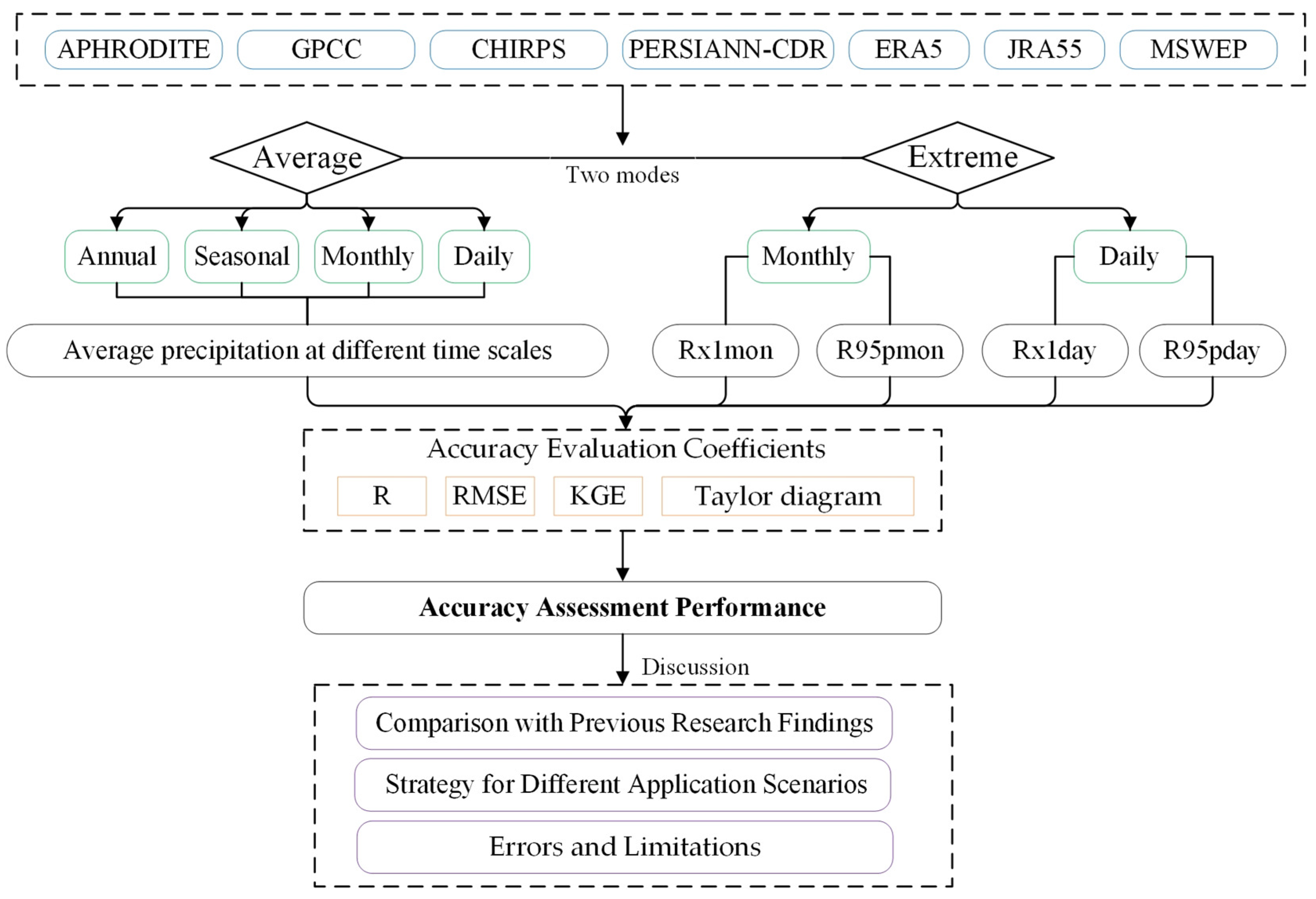

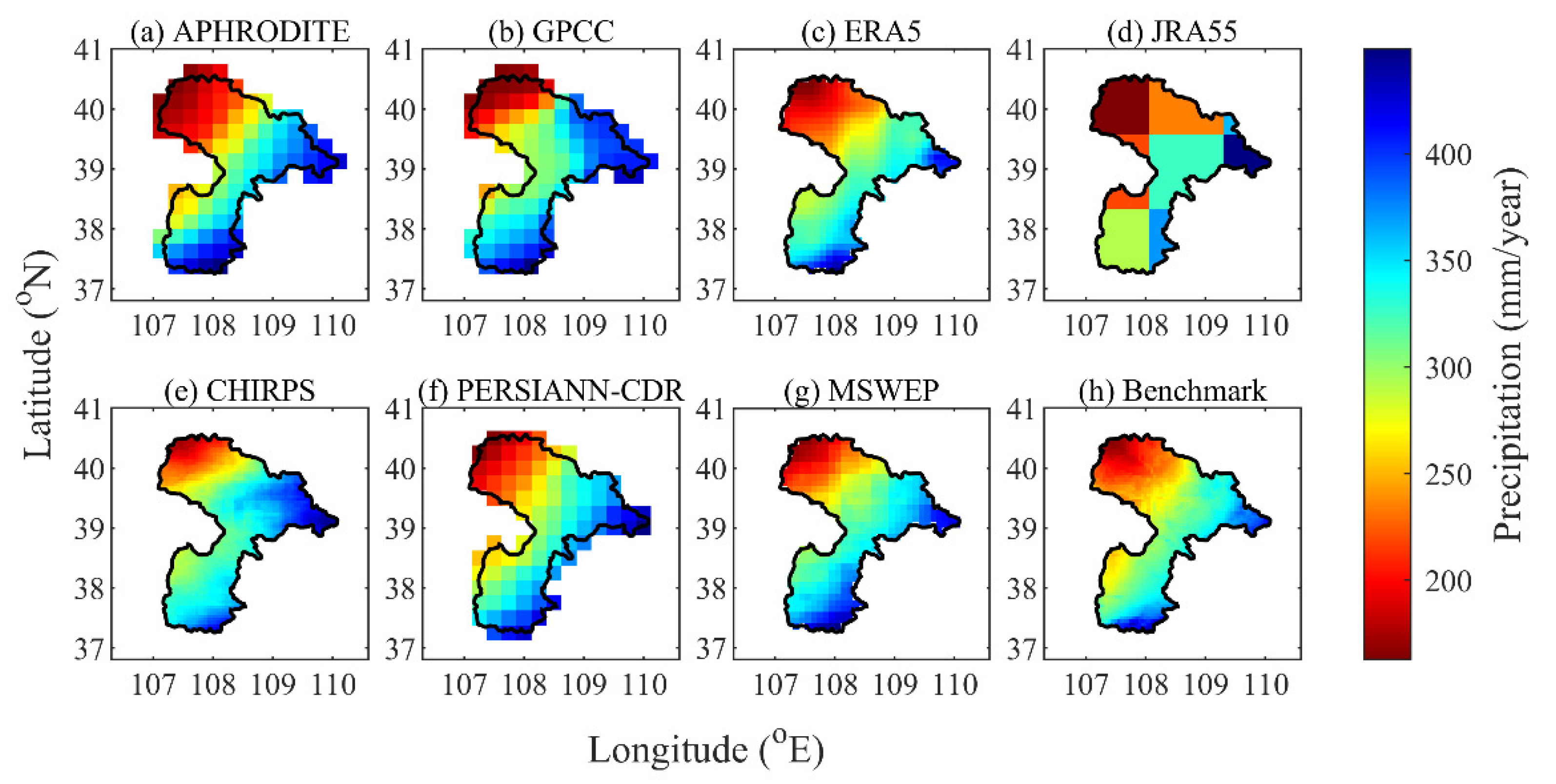

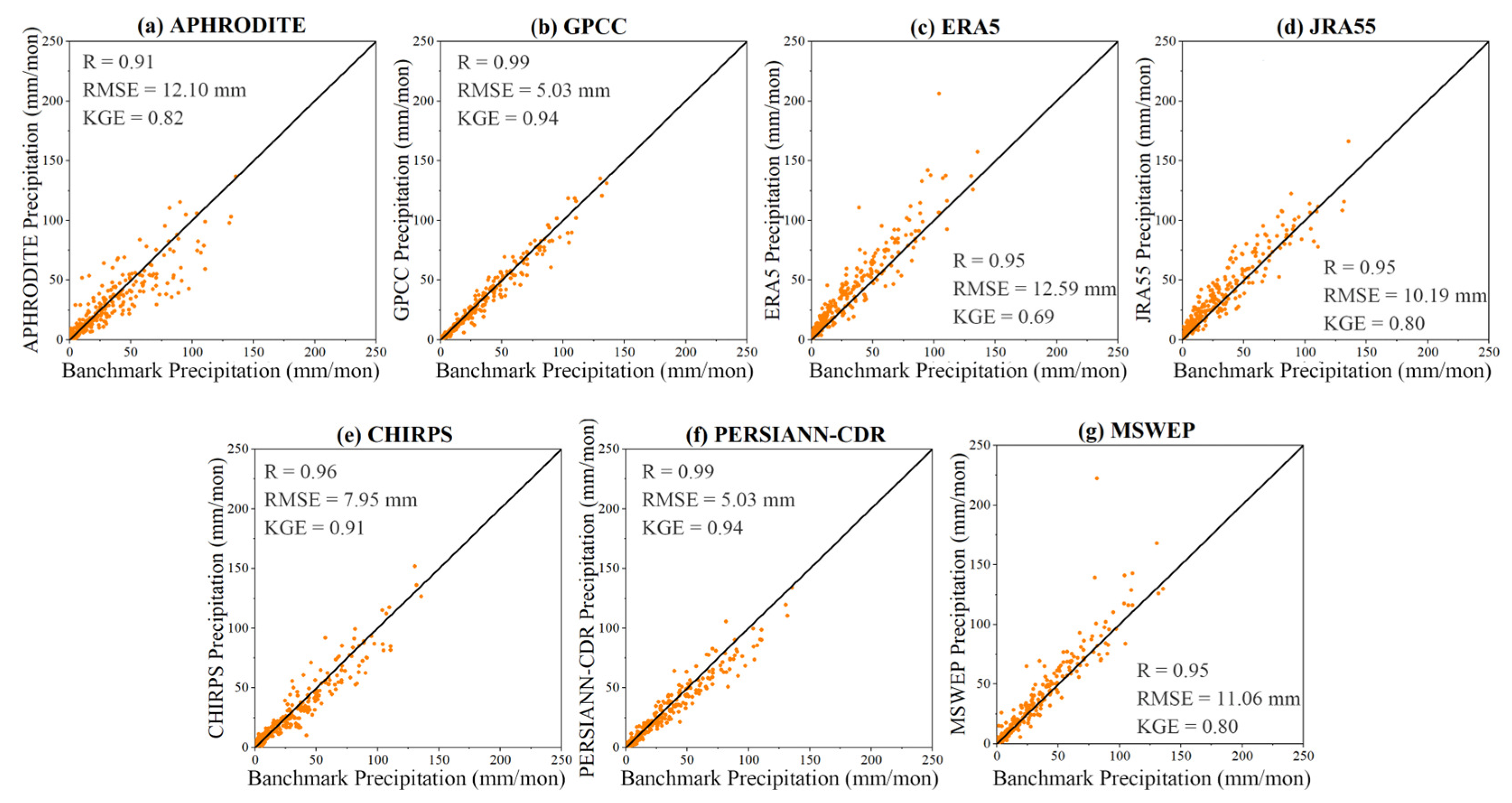
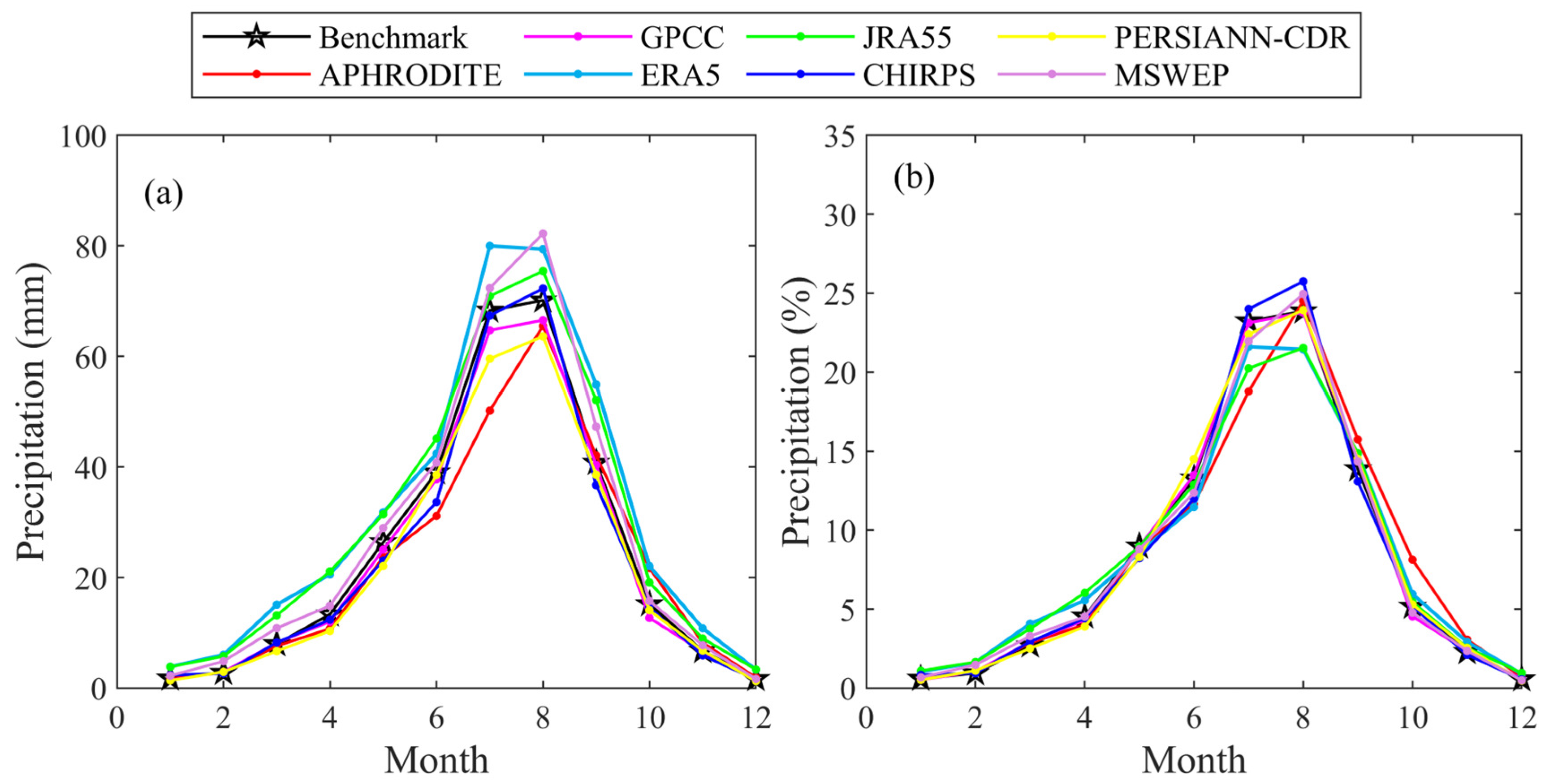
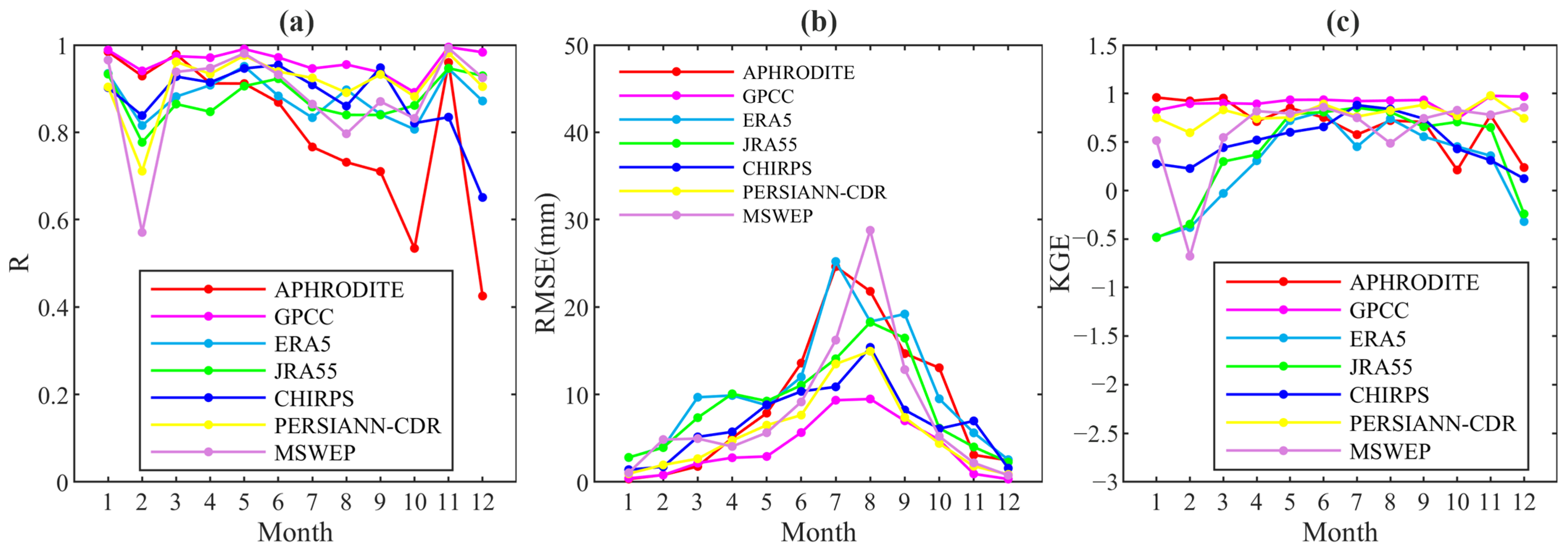
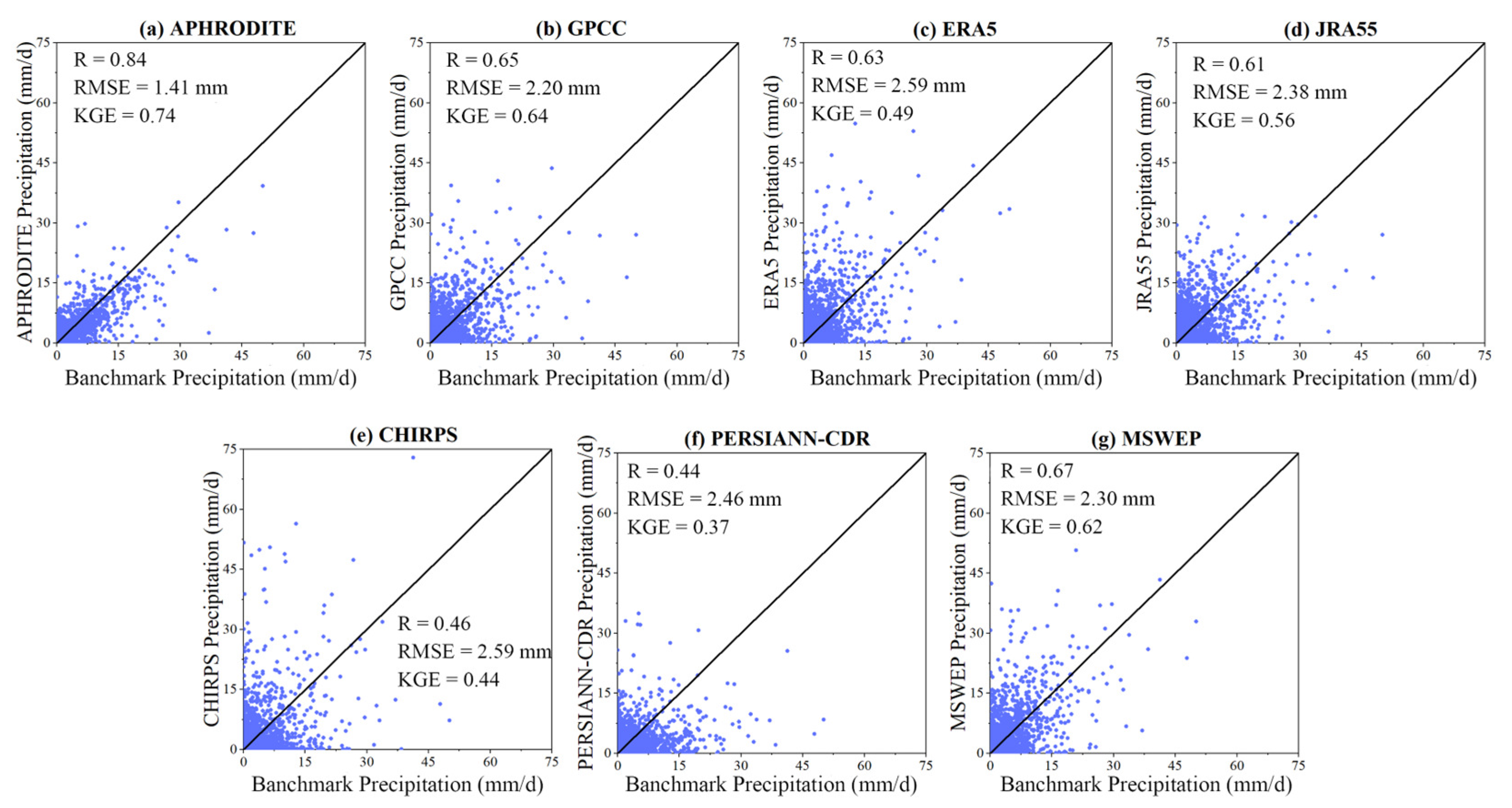
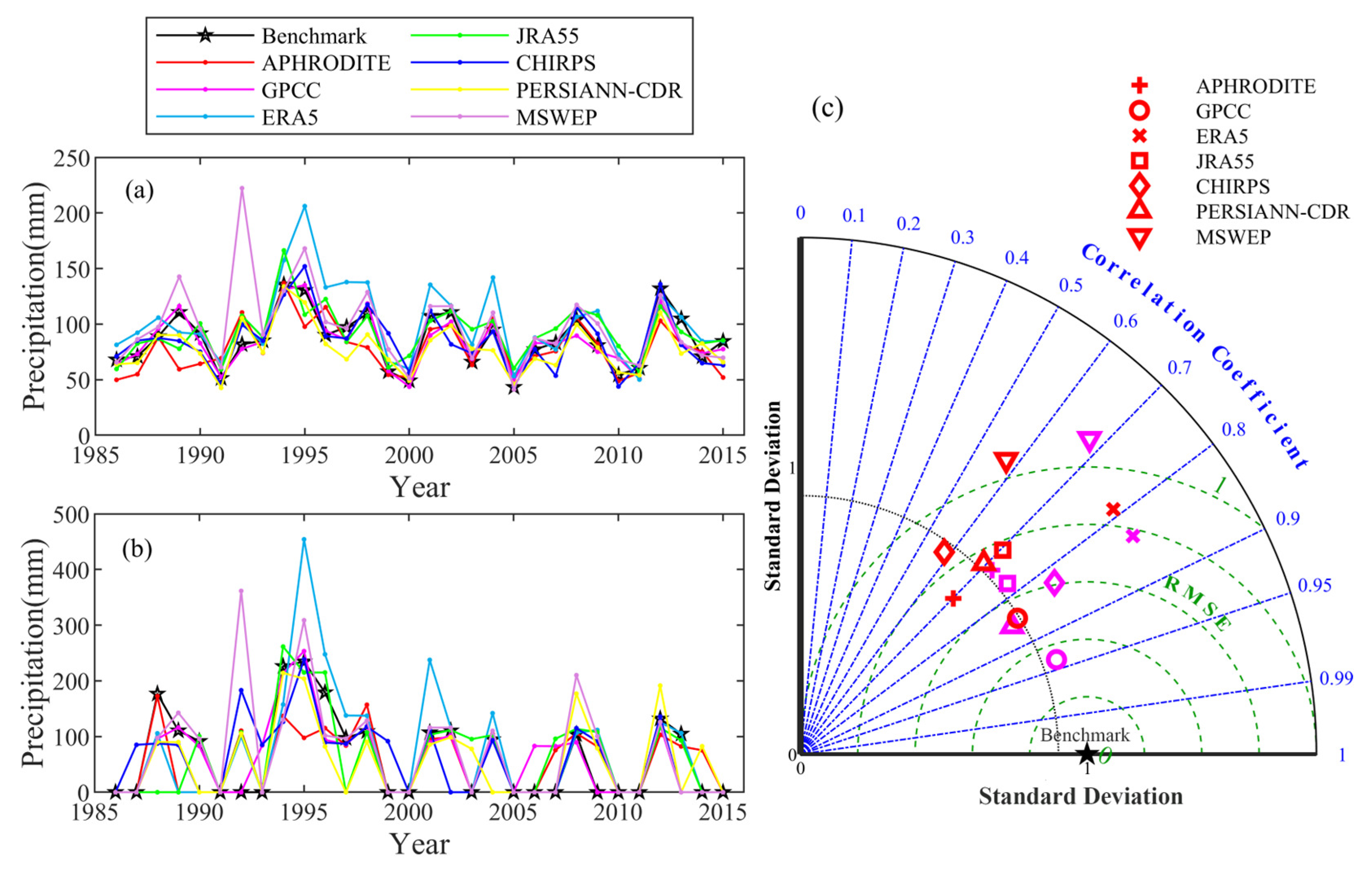
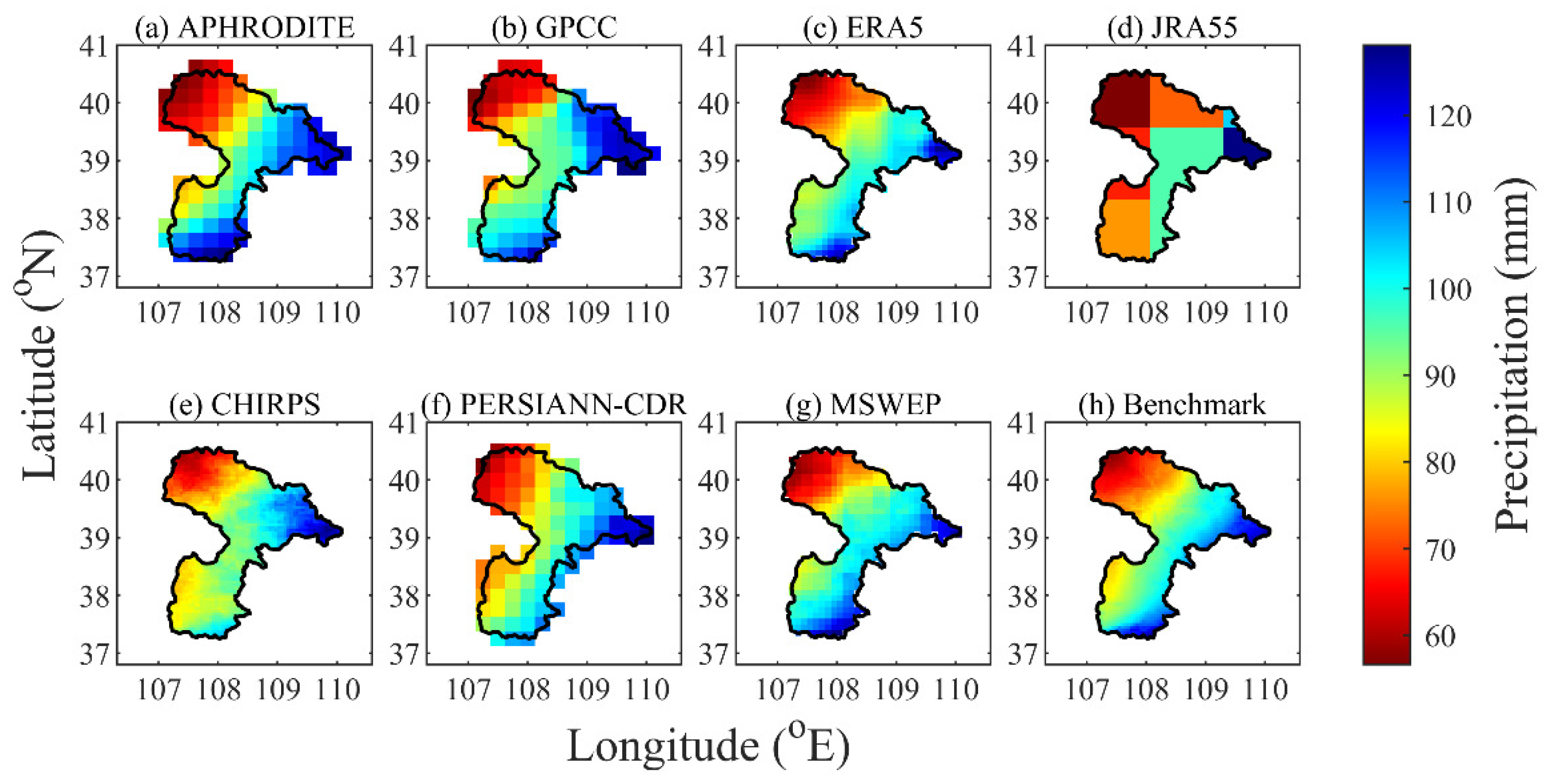
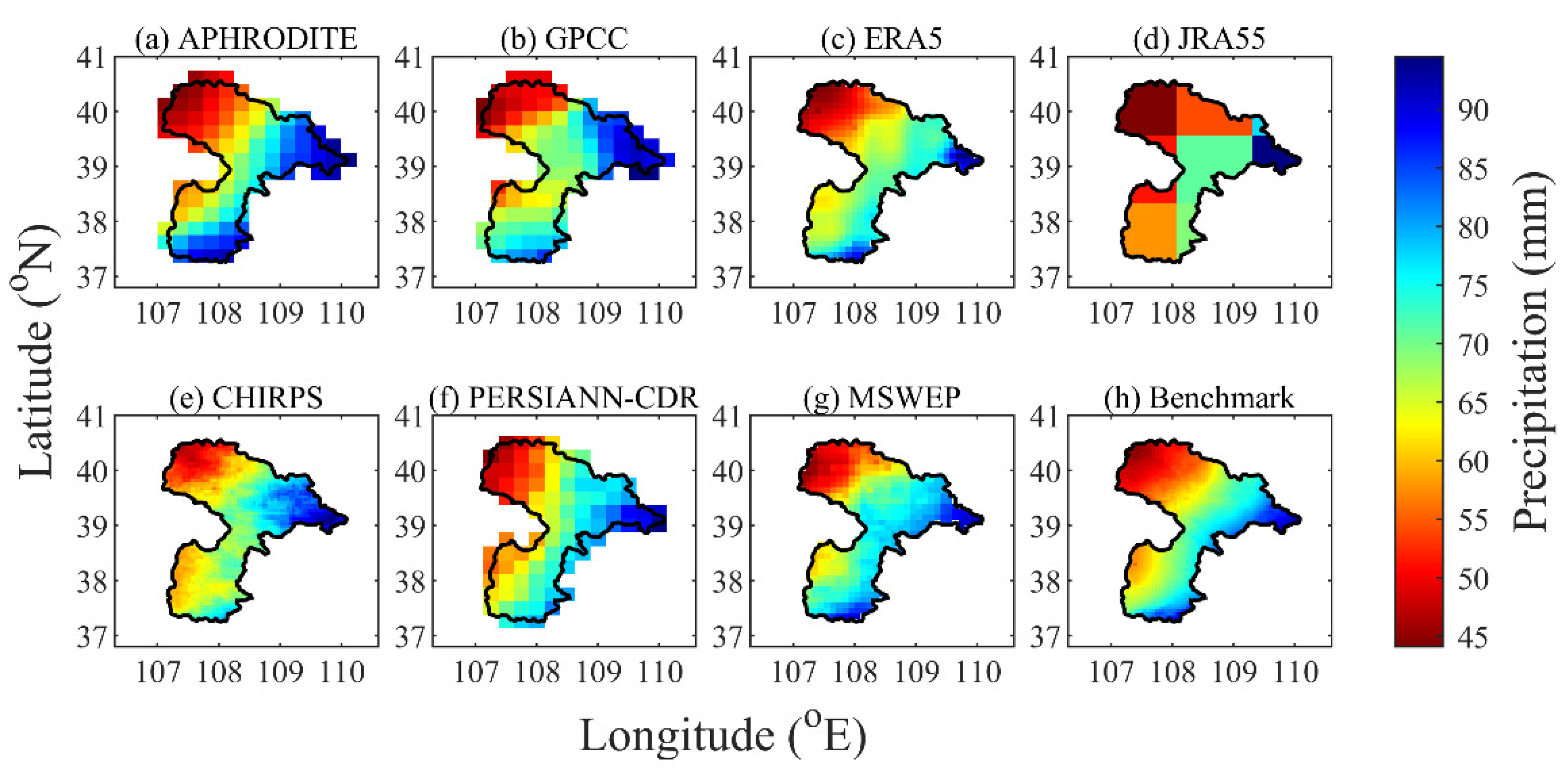

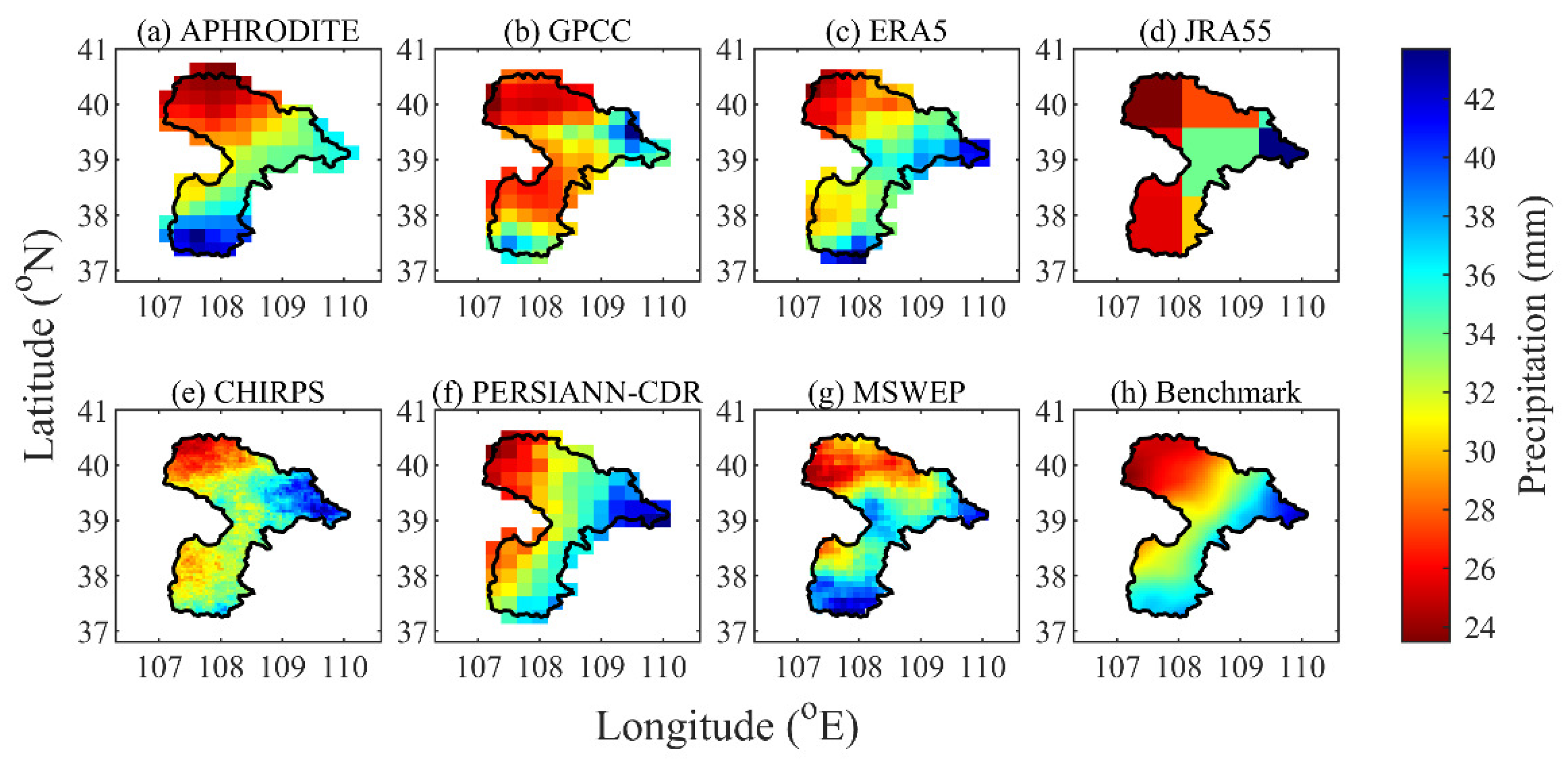

| Product Types | Datasets | Time Range | Time Resolution | Spatial Resolution | Data Sources |
|---|---|---|---|---|---|
| Measurement-based | APHRODITE | 1951–2015 | Daily | 0.25° | http://aphrodite.st.hirosaki-u.ac.jp/download/ (accessed on 25 May 2023) |
| GPCC | 1982–2020 | Daily/Monthly | 1.0°/0.25° | https://opendata.dwd.de/climate_environment/GPCC/html/download_gate.html (accessed on 25 May 2023) | |
| Reanalysis-based | ERA5 | 1950–present | Daily/Monthly | 0.25°/0.1° | https://cds.climate.copernicus.eu/cdsapp#!/software/app-c3s-daily-era5-statistics?tab=app (accessed on 27 May 2023) |
| JRA55 | 1958–present | Daily | 1.25° | https://search.diasjp.net/en/dataset/JRA55 (accessed on 29 May 2023) | |
| Remote sensing-based | CHIRPS | 1981–present | Daily | 0.05° | https://data.chc.ucsb.edu/products/CHIRPS-2.0/ (accessed on 5 June 2023) |
| PERSIANN-CDR | 1983–present | Daily | 0.25° | https://chrsdata.eng.uci.edu/ (accessed on 5 August 2023) | |
| Multi-Source | MSWEP | 1979–present | Daily | 0.1° | https://www.gloh2o.org/mswep/ (accessed on 25 August 2023) |
| Type of Indexes | Indexes | Definition | Unit | Equation |
|---|---|---|---|---|
| Extremum | Rx1day | Max 1-day precipitation amount | mm | |
| Rx1mon | Max 1-month precipitation amount | mm | ||
| Extreme threshold value | R95pday | Annual total wet-day precipitation | mm | |
| R95pmon | Annual total wet-month precipitation | mm |
| Precipitation Products | Evaluation Coefficients | Multi-Year Average Value | |||
|---|---|---|---|---|---|
| R | RMSE | KGE | Datasets | Benchmark | |
| (mm) | (mm) | (mm) | |||
| APHRODITE | 0.96 | 38.3 | 0.81 | 259.5 | 293.8 |
| GPCC | 0.96 | 20.2 | 0.93 | 279.9 | |
| ERA5 | 0.78 | 88.3 | 0.54 | 370.2 | |
| JRA55 | 0.83 | 65.1 | 0.74 | 350.3 | |
| CHIRPS | 0.79 | 35.8 | 0.71 | 280.8 | |
| PERSIANN-CDR | 0.93 | 33.5 | 0.87 | 266.9 | |
| MSWEP | 0.76 | 62.6 | 0.48 | 329.5 | |
| Season | Precipitation Products | Evaluation Coefficients | Multi-Year Average Value | |||
|---|---|---|---|---|---|---|
| R | RMSE | KGE | Datasets | Benchmark | ||
| (mm) | (mm) | (mm) | ||||
| Spring | APHRODITE | 0.97 | 8.8 | 0.84 | 42.0 | 47.7 |
| GPCC | 1.00 | 3.8 | 0.93 | 45.3 | ||
| ERA5 | 0.96 | 24.2 | 0.39 | 67.4 | ||
| JRA55 | 0.95 | 20.1 | 0.61 | 65.7 | ||
| CHIRPS | 0.94 | 13.6 | 0.54 | 43.7 | ||
| PERSIANN-CDR | 0.96 | 11.2 | 0.78 | 39.1 | ||
| MSWEP | 0.97 | 11.3 | 0.73 | 54.7 | ||
| Summer | APHRODITE | 0.87 | 38.2 | 0.71 | 146.8 | 177.4 |
| GPCC | 0.96 | 16.1 | 0.93 | 169.0 | ||
| ERA5 | 0.87 | 41.5 | 0.54 | 201.8 | ||
| JRA55 | 0.85 | 30.4 | 0.79 | 191.5 | ||
| CHIRPS | 0.86 | 23.5 | 0.83 | 173.3 | ||
| PERSIANN-CDR | 0.94 | 21.9 | 0.89 | 161.8 | ||
| MSWEP | 0.81 | 45.5 | 0.45 | 195.3 | ||
| Autumn | APHRODITE | 0.88 | 16.6 | 0.80 | 72.0 | 62.7 |
| GPCC | 0.98 | 6.7 | 0.95 | 59.6 | ||
| ERA5 | 0.89 | 28.1 | 0.59 | 87.8 | ||
| JRA55 | 0.89 | 31.5 | 0.70 | 80.1 | ||
| CHIRPS | 0.92 | 14.1 | 0.62 | 57.2 | ||
| PERSIANN-CDR | 0.97 | 7.8 | 0.87 | 59.4 | ||
| MSWEP | 0.92 | 14.3 | 0.81 | 70.8 | ||
| Winter | APHRODITE | 0.73 | 2.9 | 0.58 | 6.4 | 6.2 |
| GPCC | 0.95 | 1.0 | 0.94 | 6.0 | ||
| ERA5 | 0.77 | 8.0 | −0.41 | 13.2 | ||
| JRA55 | 0.78 | 7.6 | −0.30 | 13.0 | ||
| CHIRPS | 0.64 | 2.8 | 0.17 | 6.6 | ||
| PERSIANN-CDR | 0.70 | 2.8 | 0.63 | 5.7 | ||
| MSWEP | 0.68 | 5.1 | −0.01 | 8.7 | ||
| Extreme Precipitation Index | Precipitation Products | Evaluation Coefficients | Multi-Year Average Value | |||
|---|---|---|---|---|---|---|
| R | RMSE | KGE | Datasets | Benchmark | ||
| (mm) | (mm) | (mm) | ||||
| Rx1mon | APHRODITE | 0.72 | 19.3 | 0.70 | 78.6 | 86.4 |
| GPCC | 0.94 | 8.7 | 0.92 | 84.2 | ||
| ERA5 | 0.84 | 24.2 | 0.55 | 101.5 | ||
| JRA55 | 0.77 | 17.1 | 0.75 | 92.5 | ||
| CHIRPS | 0.83 | 14.9 | 0.82 | 85.0 | ||
| PERSIANN-CDR | 0.86 | 14.9 | 0.78 | 78.5 | ||
| MSWEP | 0.68 | 29.2 | 0.40 | 97.9 | ||
| R95pmon | APHRODITE | 0.70 | 53.5 | 0.60 | 56.6 | 62.6 |
| GPCC | 0.85 | 39.6 | 0.81 | 60.5 | ||
| ERA5 | 0.79 | 65.2 | 0.51 | 76.2 | ||
| JRA55 | 0.71 | 57.2 | 0.70 | 64.9 | ||
| CHIRPS | 0.58 | 64.1 | 0.56 | 60.8 | ||
| PERSIANN-CDR | 0.69 | 56.7 | 0.66 | 55.6 | ||
| MSWEP | 0.57 | 80.0 | 0.47 | 74.7 | ||
| Extreme Precipitation Index | Precipitation Products | Evaluation Coefficients | Multi-Year Average Value | |||
|---|---|---|---|---|---|---|
| R | RMSE | KGE | Datasets | Benchmark | ||
| (mm) | (mm) | (mm) | ||||
| Rx1day | APHRODITE | 0.78 | 10.5 | 0.52 | 23.2 | 31.9 |
| GPCC | 0.67 | 7.3 | 0.64 | 30.1 | ||
| ERA5 | 0.56 | 11.7 | 0.49 | 39.0 | ||
| JRA55 | 0.25 | 9.8 | 0.09 | 28.9 | ||
| CHIRPS | 0.63 | 22.9 | 0.16 | 52.5 | ||
| PERSIANN-CDR | 0.58 | 12.5 | 0.45 | 22.2 | ||
| MSWEP | 0.61 | 10.0 | 0.54 | 35.8 | ||
| R95pday | APHRODITE | 0.95 | 42.7 | 0.71 | 166.0 | 204.9 |
| GPCC | 0.93 | 18.2 | 0.92 | 202.1 | ||
| ERA5 | 0.76 | 64.7 | 0.50 | 251.9 | ||
| JRA55 | 0.76 | 38.8 | 0.75 | 222.5 | ||
| CHIRPS | 0.81 | 51.7 | 0.69 | 247.4 | ||
| PERSIANN-CDR | 0.87 | 65.2 | 0.68 | 144.9 | ||
| MSWEP | 0.74 | 59.1 | 0.40 | 233.9 | ||
| Time | Mode | Application Scenarios | Recommended Products |
|---|---|---|---|
| Long-term or seasonal | Average | Water resource management, agricultural production, reservoir scheduling, water conservancy construction, water ecology protection | GPCC |
| Short-term | Average | Flood forecasting, drought management, water quality testing, operation of reservoirs and hydropower stations | APHRODITE, MSWEP |
| Extreme | Extreme precipitation forecasting, flood and drought management | GPCC | |
| Quasi-real-time | Average | Hydrological forecasting, urban drainage system management, water disaster prevention and control | MSWEP |
| Extreme | Debris flow and landslide disaster warning and control | CHIRPS, PERSIANN-CDR |
| Interpolation Method | ME (mm) | RMSE (mm) | Average Multi-Year Precipitation (mm) |
|---|---|---|---|
| IDW | −4.6 | 25.4 | 283.5 |
| OK | −0.8 | 16.0 | 283.8 |
| Co-kriging | 0.2 | 9.2 | 282.1 |
| ANUSPLIN | 0.2 | 4.7 | 293.8 |
| Precipitation Products | APHRODITE | CHIRPS | JRA55 | |||
|---|---|---|---|---|---|---|
| Spatial Resolution | Original | Post-Interpolation | Original | Post-Interpolation | Original | Post-Interpolation |
| 0.25° | 0.1° | 0.05° | 0.1° | 1.25° | 0.1° | |
| R | 0.96 | 0.96 | 0.79 | 0.79 | 0.83 | 0.83 |
| RMSE (mm) | 38.3 | 39.0 | 35.8 | 36.1 | 65.1 | 61.4 |
| KGE | 0.81 | 0.80 | 0.71 | 0.71 | 0.74 | 0.75 |
| Average multi-year precipitation (mm) | 259.9 | 259.9 | 280.8 | 281.6 | 350.3 | 347.2 |
Disclaimer/Publisher’s Note: The statements, opinions and data contained in all publications are solely those of the individual author(s) and contributor(s) and not of MDPI and/or the editor(s). MDPI and/or the editor(s) disclaim responsibility for any injury to people or property resulting from any ideas, methods, instructions or products referred to in the content. |
© 2024 by the authors. Licensee MDPI, Basel, Switzerland. This article is an open access article distributed under the terms and conditions of the Creative Commons Attribution (CC BY) license (https://creativecommons.org/licenses/by/4.0/).
Share and Cite
Zhu, W.; Liang, K. Applicability of Precipitation Products in the Endorheic Basin of the Yellow River under Multi-Scale in Time and Modality. Remote Sens. 2024, 16, 872. https://doi.org/10.3390/rs16050872
Zhu W, Liang K. Applicability of Precipitation Products in the Endorheic Basin of the Yellow River under Multi-Scale in Time and Modality. Remote Sensing. 2024; 16(5):872. https://doi.org/10.3390/rs16050872
Chicago/Turabian StyleZhu, Weiru, and Kang Liang. 2024. "Applicability of Precipitation Products in the Endorheic Basin of the Yellow River under Multi-Scale in Time and Modality" Remote Sensing 16, no. 5: 872. https://doi.org/10.3390/rs16050872
APA StyleZhu, W., & Liang, K. (2024). Applicability of Precipitation Products in the Endorheic Basin of the Yellow River under Multi-Scale in Time and Modality. Remote Sensing, 16(5), 872. https://doi.org/10.3390/rs16050872





